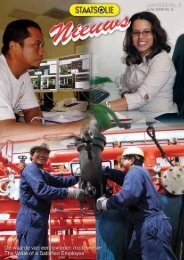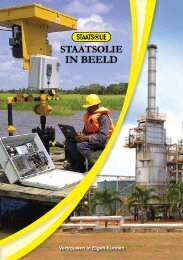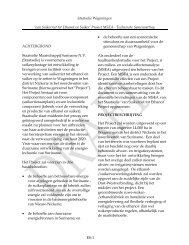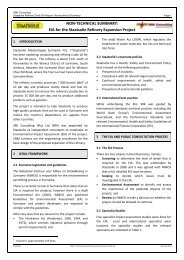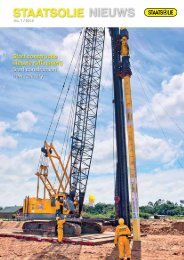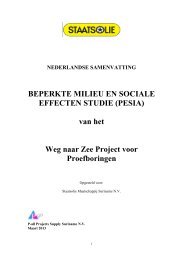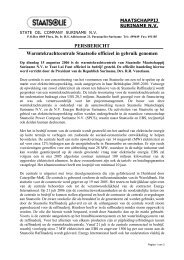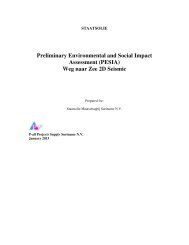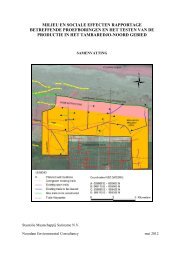concept EIA-rapport - Staatsolie
concept EIA-rapport - Staatsolie
concept EIA-rapport - Staatsolie
You also want an ePaper? Increase the reach of your titles
YUMPU automatically turns print PDFs into web optimized ePapers that Google loves.
SRK Consulting: Project No: 439414 <strong>Staatsolie</strong> Pipeline <strong>EIA</strong> – Draft <strong>EIA</strong> Report Page 91<br />
The <strong>EIA</strong> also considered the impacts of possible non-routine events, or “risks”, such as the<br />
accidental release of drilling mud during construction (frac-out) and the accidental release of<br />
hydrocarbons due to pipeline rupture or leakage. The significance of these impacts, should an<br />
incident take place, was assessed and deemed to be very low following the implementation of<br />
recommended mitigation measures.<br />
Table 7-1: Summary of potential impacts resulting from the Refinery Expansion Project<br />
Impact<br />
POTENTIAL IMPACTS<br />
Surface water pollution<br />
due to construction<br />
activities<br />
Loss or deterioration of<br />
terrestrial and aquatic<br />
habitat due to<br />
construction activities<br />
Significance rating *<br />
Before<br />
mitigation<br />
Very Low<br />
Low<br />
After<br />
mitigation<br />
Insignificant<br />
Very Low<br />
Employment creation Very Low Very Low<br />
Disruption of road and<br />
river traffic<br />
Very Low<br />
Very Low<br />
Key mitigation/optimisation measures<br />
• Consider staggering release of the surplus drilling mud<br />
over time, and at different locations, preferably in fastflowing<br />
conditions and deeper river sections to aid the<br />
rapid dispersion of the bentonite.<br />
• Consider disposing of some surplus drilling mud on land.<br />
• Comply with Project effluent quality standards for<br />
stormwater discharge.<br />
• Develop (or adapt and implement) procedures for the safe<br />
transport, handling and storage of potential pollutants.<br />
• Design and construct hazardous material storage facilities,<br />
especially fuel storage, with suitable impermeable<br />
materials and a minimum bund containment capacity<br />
equal to 110% of the largest container.<br />
• Ensure all on-site staff is trained in the use of spill<br />
prevention measures.<br />
• Minimise landtake and associated vegetation clearing /<br />
filling in the river.<br />
• Avoid disturbance to areas outside of construction areas<br />
as far as possible.<br />
• Consider maximising the employment of local workers and<br />
formalise this policy in <strong>Staatsolie</strong>’s HR guidelines and<br />
contracts.<br />
• Work closely with the local community to identify and<br />
communicate required skills and resources that the local<br />
community could provide.<br />
• Consider implementing labour-intensive rather than<br />
capital-intensive work methods wherever possible.<br />
• Consider purchasing resources from Surinamese sources<br />
wherever possible.<br />
• Attempt to time the transportation of construction workers<br />
and materials to avoid peak traffic hours as far as<br />
possible.<br />
• Ensure compliance with international and national (MAS)<br />
safety standards and procedures for barge and tanker<br />
operations.<br />
POTENTIAL RISKS (note: rating reflects impact significance should an incident take place)<br />
Accidental release of<br />
drilling mud during<br />
construction (frac-out)<br />
Low<br />
Very Low<br />
To reduce the probability of an incident (does not affect<br />
significance rating):<br />
• Monitor drilling pressures and penetration rates. Ensure<br />
that mud pressure is optimal to penetrate the formation.<br />
To reduce the impact in the event of an incident:<br />
• Visually monitor the areas around the drilling site for signs<br />
of drilling mud leakage, especially while drilling shallower<br />
sections near the entry / exit points.<br />
• Compare the estimated and actual volume of drilling mud<br />
returns, to detect escaping mud.<br />
• Cease drilling operations if returns of drilling mud<br />
decrease or if a surface release of drilling mud is detected,<br />
to determine what actions need to be taken, in line with<br />
stipulations in the EMP and the spill response plan.<br />
REUT/DALC 439414_<strong>Staatsolie</strong>Pipeline<strong>EIA</strong>_Draft <strong>EIA</strong> Report_Final June 2012




